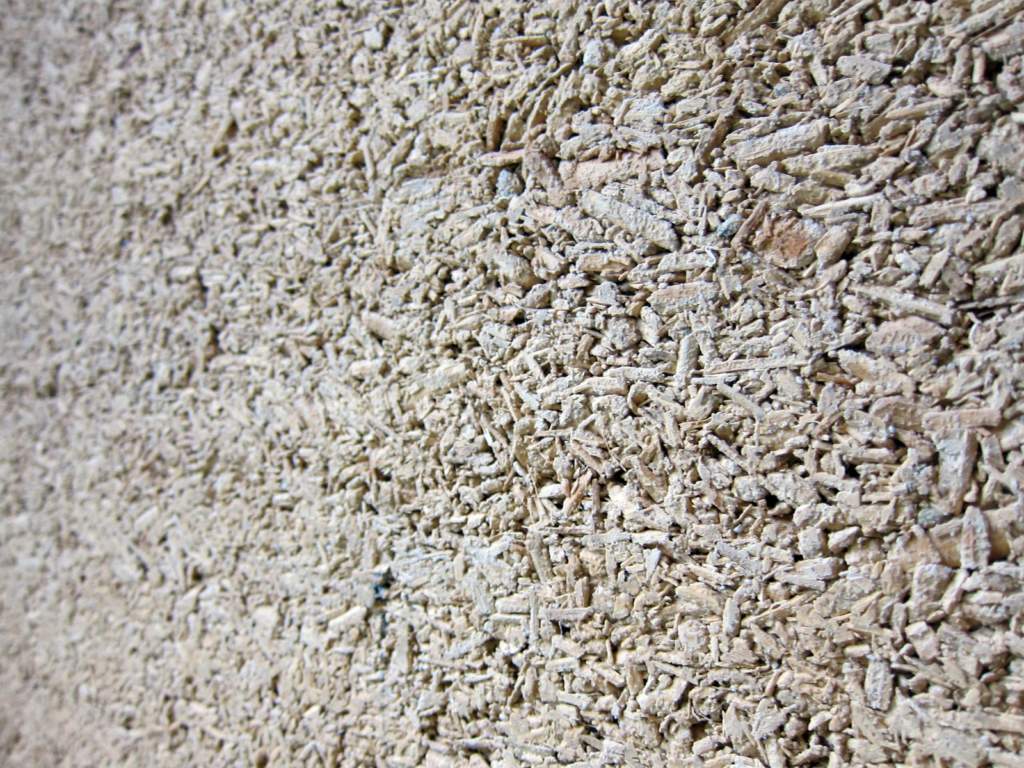
Did you know there’s a building material that’s durable, sustainable, healthier for the occupants and even carbon negative?
It’s called hempcrete, a composite made from fibers of the industrial hemp plant mixed with lime.
The United States is perfectly positioned for a hempcrete building boom. Interest in green building is growing as people seek out sustainable, low-cost alternatives to traditional buildings made from petrochemicals or dwindling natural resources like wood. At the same time, the stigma around hemp is disappearing as more learn about the plant’s benefits. Hempcrete has unique health benefits and, because it enables low cost, modular design, it could even be a part of the solution to America’s affordable housing crisis.
“It’s just an awesome material,” declared Greg Flavall, CEO of Hemp Technologies, a leading builder of hempcrete homes. “I’ve never seen anything like it and we have studied other materials like flax, corn stalks, linseed oil stalks, even wood, and hemp wins by far hands down.”
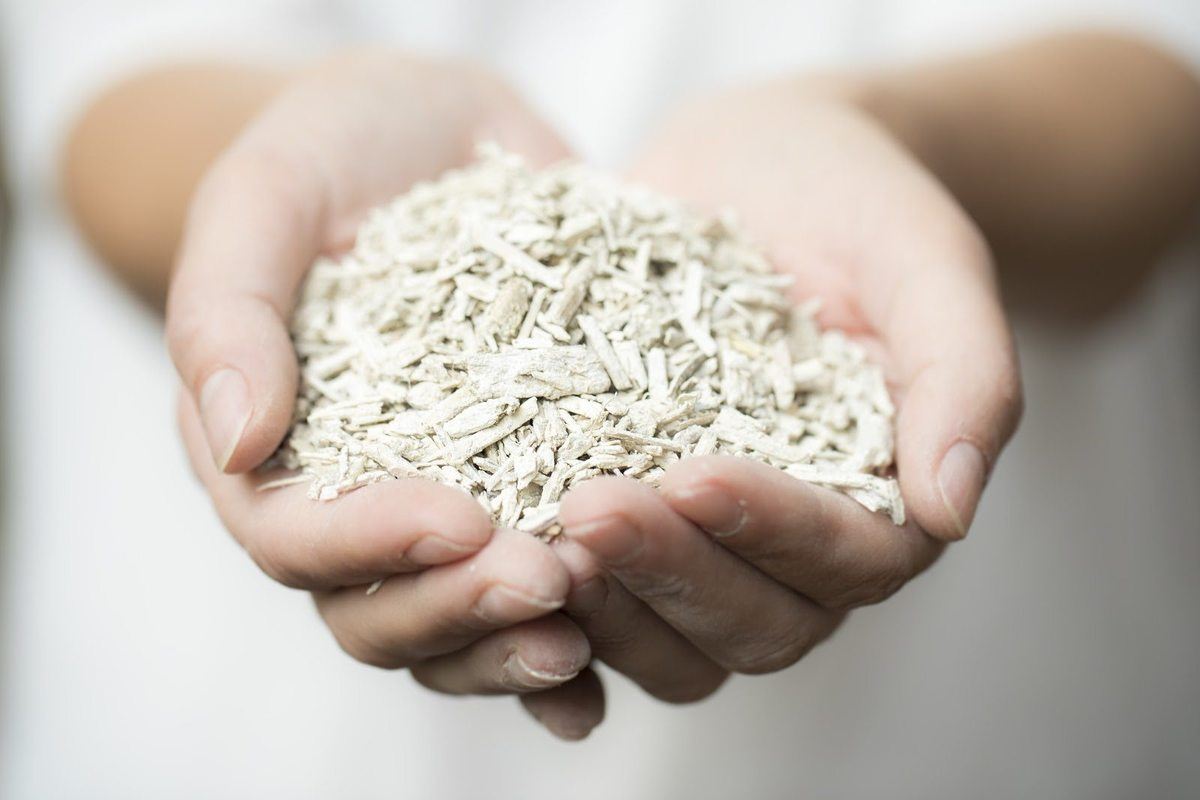
A pair of hands holding dried, shredded hemp shivs, which look a bit like wood chips. They are ready to be mixed with lime and water and formed into blocks.
In 2009, Hemp Technologies oversaw the first permitted hemp home build in North America, in North Carolina. However, hemp’s uncertain legal status sent Flavall to New Zealand, where the crop was legal to grow for use in building materials. He’s traveled the world helping create hempcrete structures ever since, working on everything from jungle cabanas to wine tasting rooms. Now that hemp is becoming popular in the U.S., demand for his services is skyrocketing here too.
We recently caught up with Flavall to learn more about why hempcrete is better than other green building materials, and to hear about one of his most recent projects, a home retrofit which could soon be part of an upcoming TV show on hempcrete homes.
HEMPCRETE IS HEALTHY, SUSTAINABLE AND AFFORDABLE TOO
Agricultural hemp is the close cousin of psychoactive cannabis or “marijuana” (the plant people consume to get high). While marijuana is prized for its flowery tops, hemp is grown for its tall, fibrous, leafy stalks which are a little bit similar to bamboo. Hempcrete is made from hemp shivs, which are the fibrous, woody core of those stalks, also known as the hurd. The shivs are chopped up into chips, which are mixed with water and a lime binder to form concrete-like stone slabs that have a pleasant, earthy appearance that many people find appealing.
Hemp is a more sustainable option than many other commonly grown crops, because it requires very few pesticides and can easily be grown in very dense plots. But the benefits don’t stop there, especially when it comes to hempcrete homes.
“We have seen, anecdotally, reductions in healthcare cost and absenteeism because of living in a hemp building,” Flavall said.
Like many aspects of hemp science, more research will be needed to prove how significant a health benefit hempcrete can have for its occupants, but Flavall’s claims make sense when you consider the many documented beneficial characteristics of the material. Much like the original hemp plant, hempcrete is known to be extremely pest resistant. It’s also extremely durable and fire resistant, which is especially important when Flavall builds in environments like New Zealand, where both rain and seismic tremors are extremely frequent.
“Hempcrete works so extremely well. It dries out, it continues to breathe, and it makes the indoor quality of living phenomenal.”
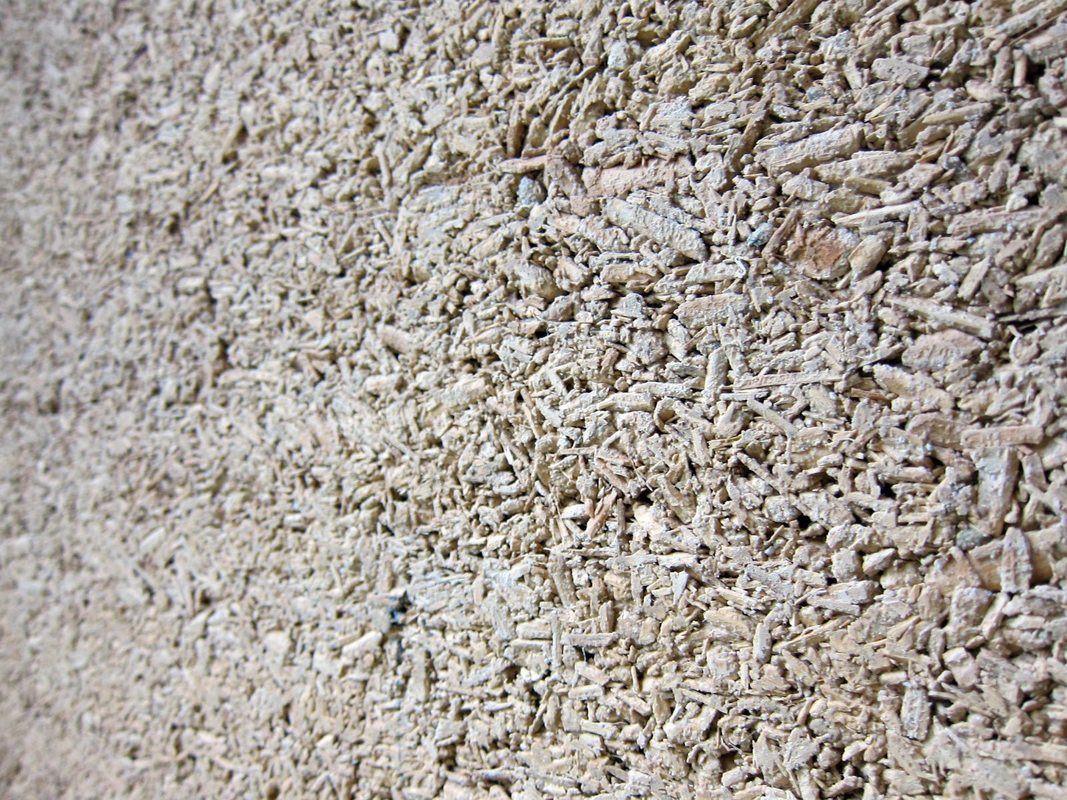
A close up of the surface of a hempcrete wall. The woody texture of the hemp shivs is still visible in the finished product, which many homebuilders find appealing. (Photo: Flickr / Jnzi’s Photos, CC-BY Creative Commons license)
As hempcrete dries, it absorbs the carbon dioxide produced by the occupants and grows harder, essentially turning to stone. Not only does this make the building stronger, but it makes hempcrete into a carbon-negative building material by leaving less of the greenhouse gas in the atmosphere than is produced by building with it. Even in this form, hempcrete remains “breathable” — homes remain rain proof but permeable to gases and moisture are less prone to mold and better for the overall health of their occupants.
According to Flavall’s calculations, hempcrete buildings in the U.S. remain carbon neutral even though most of the hemp used in current building projects must be imported from overseas. It’s also a surprisingly affordable option: he said it meets or beats other common building materials in up-front costs when used properly, in addition to incredible savings on heating and cooling costs over the lifetime of the building.
“At the end of the day when you turn the key to move into your new home you’re at the same price as regular construction,” Flavall said.
MAKING FRIENDS WITH HEMPCRETE: HEMP HOME RETROFIT BECAME A ‘RELATIONSHIP BUILDER’ FOR PETERSEN FAMILY
“Our hempcrete project began with a passion for natural building,” Stacey Petersen told us.
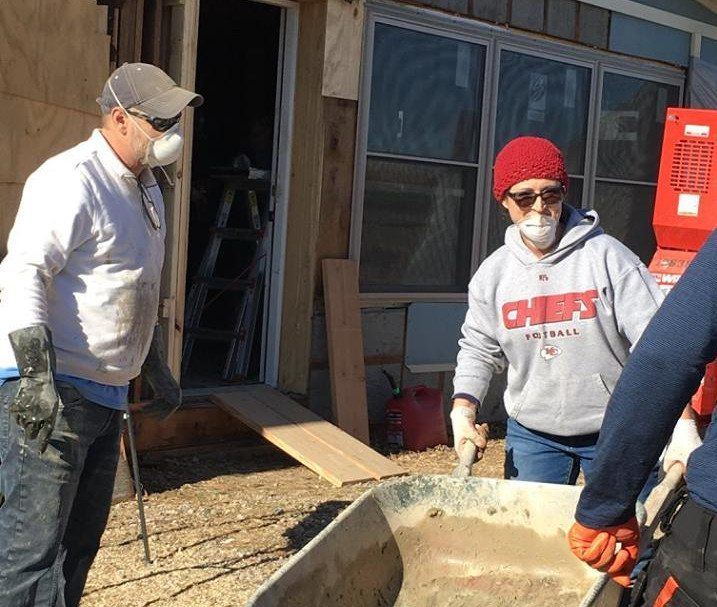
Greg Flavall (left) with Stacey Petersen holding a wheelbarrow, during the hempcrete retrofit of the Petersen’s home in Missouri. Building with hempcrete was so easy, everyone could help out. (Photo: Facebook / HT Global Hemp House Build TV Series, used with permission).
After other sustainable building fans tipped her off to their work, Greg Flavall and Hemp Technologies led a major hempcrete retrofit of the Petersen family’s home, located in Excelsior Springs, Missouri, in December 2017.
The simplicity of working with hempcrete allowed everyone, even family friends, to participate in the building process.
“It’s not rocket science to build like this and it really brings people together,” Petersen recalled. “It was a relationship builder on top of having our house insulated with hempcrete.”
Stacey’s husband, Jon Petersen, is the Pastor of Ministries at Desperation Church In Liberty, Missouri, and their embrace of the hemp is another sign that the stigma around this misunderstood crop is disappearing. Not only are they already planning their next hemp project using leftover supplies (“a greenhouse or a mother-in-law cottage,” Petersen told us), but they also use CBD oil, an extract of industrial hemp, to ease symptoms of severe epilepsy in their 10-year old son, Jeriah.
A growing body of research suggests CBD oil helps kids with epilepsy, and that’s been true for Jeriah as well. While not a miracle cure — he still suffers from severe seizures that sometimes land him in the hospita l– the supplement seems to reduce the number of seizures. Perhaps even more importantly, Stacey Petersen believes it helped the family wean Jeriah off a potentially dangerous medication which was actually making his symptoms worse.
‘There’s one kid in Colorado who’s been trying to wean this drug for a year and a half, it’s so intense, and we were able to do it in about 2 months.”
The Petersens are continuing to use CBD as Jeriah explores other forms of treatment, and his illness also inspired their interest in hempcrete. Since Jeriah uses a wheelchair, the Petersens swapped their previous multi-story home for single-story 1960s house of about 2300 square feet.
“My son, obviously he has a lot of challenges so we need healthiest living environment possible for him,” Stacey Petersen said when I asked her about the appeal of hempcrete.
But she also told us she loves that hempcrete is fire and termite resistant, and requires very little upkeep. “Anything to make my life more simple I’m all about that!”
HEMPCRETE HOMES ON TV AND HEMPCRETE AFFORDABLE HOUSING: LOOKING TOWARD THE FUTURE
The retrofit of the Petersen’s new home was filmed for a prospective new TV series, “HT Global Hemp House Build,” currently being developed in a partnership between Flavall and Diana Oliver of Thunderbird Productions, producer of the Hempsters documentary series. The show is currently seeking sponsors, but they’ve already filmed multiple episodes including the one featuring the Petersens which will be cleverly titled “The Hempster and the Pastor.”
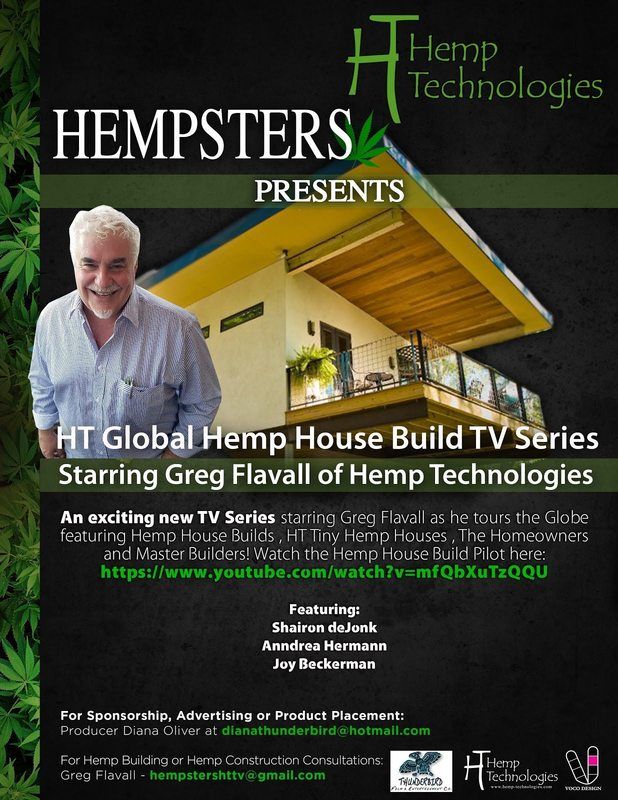
Poster for the upcoming TV show, “HT Global Hemp House Build TV Series,” from Hemp Technologies and Thunderbird Film & Entertainment Co..
Flavall and Oliver worked together on a pilot episode in 2011, along with Ervin Dargon of Mingo Video, but the sudden death of Flavall’s business partner, Dave Madera, from cancer, cut the initial phase of the project short. The first episode is dedicated to Madera.
Last year, with Flavall once again building with hempcrete in the U.S., they decided to revive the show.
Oliver told us, “It’s a homeowners dream to lessen their carbon footprint and build a beautiful house to last generations that is mold, pest and fire retardant.”
The timing for a show like this seems perfect to Flavall, who said interest in hemp and hempcrete is booming. Even though he’s been legally building with hempcrete in the U.S. and elsewhere for almost a decade, he credits the current rising interest to the spread of marijuana legalization.
“I’m a Baby Boomer and I’m seeing a lot of those Baby Boomers coming back to me and saying ‘I guess now that it’s legal to smoke it’s legal to build with it.’”
Next, Flavall hopes to help tackle the affordable housing crisis in the U.S. by building add-on units to existing homes, made from hempcrete. “We have a lot of interest from people who have the ability to build an addition or retrofit their garage or put up a detached ‘granny flat.’”
Hemp can help “bring their mom and dad home, or bring the kids home, whichever it is, and create additional space with low impact.”
Between the growth of green building, and widespread interest in “tiny homes,” Flavall believes hempcrete has a big future in the United States.
sure would be nice to support local farmers in buying hemp shiv. Seems that it is nearly impossible to find them that are not imported from China or France or the UK. The cost of shipping is much larger than the cost of the shiv. Really folks.. I know there are people growing industrial hemp.. Guess they are dumping most and only harvesting the seeds.. What a waste
ReplyDelete